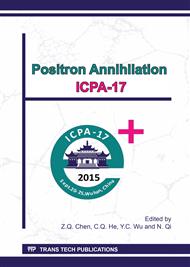p.284
p.288
p.295
p.299
p.303
p.309
p.313
p.317
p.324
Application and Evaluation of 3D Printed Materials with PALS
Abstract:
In this study, the use of a 3D printer for sample holder fabrication and polymer sample preparation for positron analysis was explored. Custom printed 3D holders may be rapidly made and modified for a variety of thin-film, crystalline, or other diversely-shaped samples. For positron studies a 3D printer allows for the preparation of standard and unique polymer samples. In an initial study, a mesoporous-patterned ABS sample was attempted, without success. Various polymers (ABS, PLA, and PETG) and the same polymers with varied additives (carbon fiber or carbon nanotubes) were studied before and after printing. The different polymers and those with additives are distinguishable via PALS. Samples show a consistently lower I3 value after printing, suggesting a decrease in defect quantity for the printed polymer versus the as-received polymer filament.
Info:
Periodical:
Pages:
303-306
Citation:
Online since:
March 2017
Authors:
Keywords:
Price:
Сopyright:
© 2016 Trans Tech Publications Ltd. All Rights Reserved
Share:
Citation:


